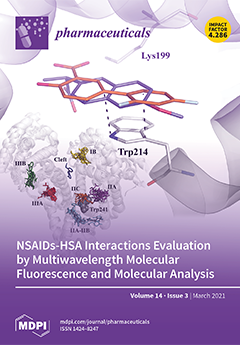Ficus glumosa Delile (Moraceae), a reputed plant that is used in herbal medicine, is of high medicinal and nutritional value in local communities primarily ascribed to its phytochemical profile. Currently, there are hardly any fine details on the chemical profiling and pharmacological evaluation
[...] Read more.
Ficus glumosa Delile (Moraceae), a reputed plant that is used in herbal medicine, is of high medicinal and nutritional value in local communities primarily ascribed to its phytochemical profile. Currently, there are hardly any fine details on the chemical profiling and pharmacological evaluation of this species. In this study, the flavonoids and phenolics contents of the ethanol extracts and four extracted fractions (petroleum ether (PE), ethyl acetate (EA),
n-butanol, and water) of the stem bark of
Ficus glumosa were firstly quantified. Further, their antioxidant and antiproliferative potentials were also evaluated. The quantitative determination indicated that the EA and
n-butanol fractions possessed the highest total flavonoids/phenolics levels of 274.05 ± 0.68 mg RE/g and 78.87 ± 0.97 mg GAE/g, respectively. Similarly, for the 2,2-diphenyl-1-picrylhydrazyl (DPPH), 2,2′-azino-bis-(3-ethylbenzothiazoline-6-sulfonic acid) (ABTS), and ferric-reducing antioxidant power (FRAP) assays, the EA fraction exhibited high potency in both DPPH and ABTS
+ scavenging activities with IC
50 values of 0.23 ± 0.03 mg/mL, 0.22 ± 0.03 mg/mL, and FRAP potential of 2.81 ± 0.01 mg Fe
2+/g, respectively. Furthermore, the EA fraction displayed high cytotoxicity against human lung (A549) and colon (HT-29) cancer cells. Additionally, the liquid chromatography coupled with electrospray ionization tandem mass spectrometry (LC-ESI-MS/MS) was employed in order to characterize the chemical constituents of the EA fraction of
Ficus glumosa stem bark. Our findings revealed 16 compounds from the EA fraction that were possibly responsible for the strong antioxidant and anti-proliferative properties. This study provides edge-cutting background information on the exploitation of
Ficus glumosa as a potential natural antioxidant and anti-cancer remedy.
Full article






